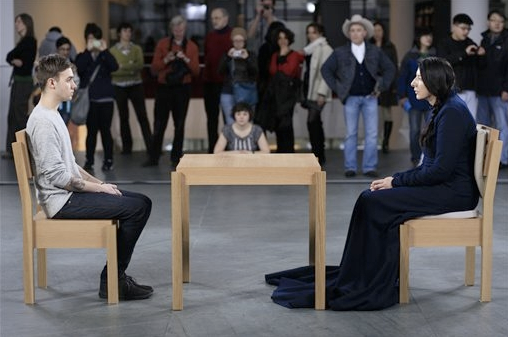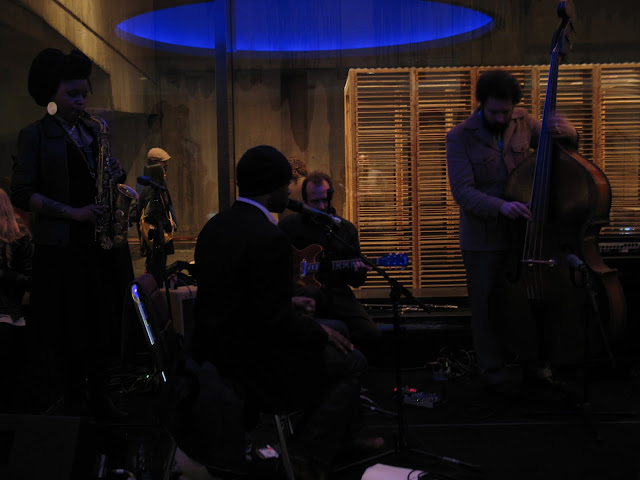Tuesday, March 8, 2011
Monday, May 10, 2010
ART REVIEW | Alessandra Sanguinetti @ AIB Gallery
I had never known the work of Alessandra Sanguinetti until I came to school to study photography. I immediately fell in love with her work featuring two cousins, “The Adventures of Guille and Belinda and the Enigmatic Meaning of Their Dreams.” I was drawn to these fantastical images in which young girls performed their visions of growing up. Sanguinetti captures the girls as they play dress up, wear wedding dresses, have pregnant bellies and ultimately hold a fake funeral. Although critics have questioned whether or not Sanguinetti forcefully instructs the girls, in her artist talk she discussed how “any other way of representing the girls would be a lie.” She doesn’t consider her photographs planned or scheduled, it is more of improvisation.
Sanguinetti has photographed these girls in the most pivotal years of their lives, a time where their bodies and minds are rapidly changing. She has captured their awkward moments and all their different personas as nine and ten year olds. As the girls play “make believe”, audiences are given insight into their lives and how they think. Guille for instance, is already worried about men leaving her because of what she’s seen in movies. Belinda is seen experimenting with different personas throughout the photographs; dressing as a man, explorer and a nun. Although these girls are playing, they are not acting out what one would assume young girls would act out. Guille and Belinda do not pretend they are princesses or animals, rather they are imagining themselves in a different period of their lives. Their mature ideas suggest the end of childhood and what is to come.
Just as in “The Adventures of Guille and Belinda and the Enigmatic Meaning of Their Dreams,” Sanguinetti acts as a witness in her series entitled, “On the Sixth Day.” She first started photographing as a young girl when she realized that someday everyone would die. Her need to document these things pays respect to her subject matter and in addition creates a permanent record. “On the Sixth Day” refers directly to how God created animals on the sixth day of creating the earth. In this series, she focuses on our relationship to animals and our dominance over them. We decide when to feed, care and ultimately end the lives of animals.
Alessandra Sanguinetti, Untitled from the series On the Sixth Day, 1996-2004
There is a clear reference of man versus beast and how animals play sacrificial creatures. Her images explore the every day lives and life cycles of animals on her father’s farm in Argentina. As viewers, we get very close to these animals. We notice the rich colors of their fur, their expressions and even can begin to observe how they are feeling. We are shown things we do not see or think about often, such as a tiny cow fetus, blood stained hands and skinned animals. We get very upset when people die and excited when children are born, but it is not a big deal when an animal goes through these stages. Sanguinetti has photographed this series from a low perspective, similar to through the eyes of an animal and creates a new viewpoint for her audience. Her photographs of animals have a “fable-like” aesthetic, as she mentioned, however, a line is drawn between fantasy and real violence.
In all of Sanguinetti’s work she discusses the relationship between the real and the fantastical world. Although at first glance her work may appear highly imaginative, the realities of her subject matter are not light and comfortable.
Anna Fink is a senior photography student at the Art Institute of Boston.
Sunday, May 9, 2010
TAVARES STRACHAN @ MIT LIST
MIT LIST Visual Arts Center
May 7 to July 11, 2010
The MIT List Visual Arts Center is pleased to present Orthostatic Tolerance: It Might Not Be Such a Bad Idea if I Never Went Home, the next phase of a new project by Bahamian-born, New York-based artist Tavares Strachan. Since 2006, Strachan has been working on this multiphase body of work that explores space and deep-sea training. “Orthostatic” means to stand upright, and “tolerance” refers to the ability to withstand pressure. Combined, the phrase refers to the physiological stress that cosmonauts and deep-sea explorers endure while exiting, and re-entering our home, the thin surface of planet Earth.
The Orthostatic Tolerance mirrors Strachan’s interest in establishing an Ocean and Aerospace Exploration Agency in Nassau (BASEC) both to continue his own exploration efforts while fostering educational outreach efforts for children in his home country. Strachan is perhaps best known for the work, The Distance Between What We Have and What We Want, 2004-06. For this project, Strachan embarked on an Arctic exploration during which he extracted a 4.5-ton block of ice and shipped it to his former grade school in Nassau, where it was kept frozen by a solar-powered freezer. For a year after the Arctic remnant was installed in the sub-tropical environment, Strachan presented lectures in elementary schools throughout the Bahamas. (MIT press release excerpt)
Friday, April 30, 2010
AIB Photography BFA Thesis: Marrow Mending featuing the work of Liz Affa, Kate Bullen, Malin Sjoberg, and Tiffany Ulrich




Thursday, April 29, 2010
Fred Ricthin Lecture | PRC @ Northeastern University
Thursday, April 29, 2010
Time: 7:00pm
Location: Northeastern University (Building 20F, in West Village)
MBTA T-Stop (E-Line - Northeastern)
Click for campus map with directions
In a digital environment, what can emerge from a medium transformed? How will it change us as people? And how can we influence what comes next?
Fred Ritchin is author of the recently published book, After Photography, and has been writing on the digital challenge for media since a major article for The New York Times Magazine in 1984. He is professor of Photography and Imaging at New York University's Tisch School of the Arts, and directs PixelPress. Ritchin was picture editor of The New York Times Magazine, executive editor of Camera Arts magazine, and founding director of the Photojournalism and Documentary Photography Program at the International Center of Photography. Ritchin has also authored In Our Own Image: The Coming Revolution in Photography (1990), and his essays have appeared in other books such as In Our Time: The World As Seen by Magnum PHotographers, An Uncertain Grace: THe Photographs of Sebastiao Salgado, Mexico Through Foreign Eyes, Sahel: End of the Road, and Under Fire: Great Photographers and Writers in Vietnam. He is currently finishing another book Outside the Frame, on photography and human rights. He also writes the blog afterphotography.org.
Monday, April 26, 2010
Interview with Jenn Warren | Sudan
AIB alumna Jenn Warren will join AiC via Skype and discuss her recent documentary projects in Sudan.

Jenn Warren is a documentary photographer based in East Africa, specializing in NGO, humanitarian, and development projects. Clients include Medecins sans Frontieres, UNICEF, CARE, WFP/PAM, Amnesty International, PSI, the National Democratic Institute, SafePoint, and TASC. She was recently awarded the 2008 Nikon Emerging Professional Scholarship to attend the Missouri Photo Workshop 60 and is featured in the Best of ASMP 2008, Alligator Juniper Photography Annual 2008, and the 2008 Center for Fine Art Photography Peace Corps Exhibition.
Sunday, April 25, 2010
PLASTIC FOREST | NYT OP-ART
From the sereies Roadside Wildflowers
Photographs copyright Bryan Graf
These are photographs of plastic bags that I pulled from trees and shrubs in the woods near my home in New Jersey. To make these pictures — photograms — I took the bags into my darkroom and gently dropped them between my enlarger’s lens and a piece of light-sensitive paper. I then illuminated the scene with a flash of light for less than a second. The resulting images trace the objects gliding in the air moments before they come to rest. Like Earth Day, they are for me a prompt to reflect on the relationship — sometimes vexed, sometimes beautiful, always complicated — between humankind and nature.
Wednesday, April 21, 2010
Photography BFA Thesis, On Life and Death: Molly Geiger, Christopher Hoodlet, Tara Sellios, & Paul Yem




Tuesday, April 20, 2010
Alessandra Sanguinetti Lecture | AIB
The Art Institute of Boston at Lesley University
APRIL 20, 2010 | 6:30 pm
Room 101, Boston University Kenmore Classroom Building
565 Commonwealth Avenue, Boston
Copyright Alessandra Sanguinetti







